| Gulf of Guinea | |
|---|---|
.jpg.webp) Gulf of Guinea map showing the chain of islands formed by the Cameroon line of volcanoes | |
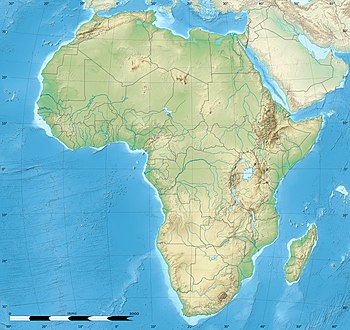 Gulf of Guinea | |
| Coordinates | 0°0′N 0°0′E / 0.000°N 0.000°E |
| River sources | Niger |
| Ocean/sea sources | Atlantic Ocean |
| Basin countries | Liberia, Ivory Coast, Ghana, Togo, Benin, Nigeria, Cameroon, Equatorial Guinea, Gabon, São Tomé and Príncipe, Republic of Congo, Democratic Republic of Congo, Angola |
| Surface area | 2,350,000 km2 (910,000 sq mi) |
| Islands | Bioko, São Tomé, Príncipe, Ilhéu Bom Bom, Ilhéu Caroço, Elobey Grande, Elobey Chico, Annobón, Corisco, Bobowasi |
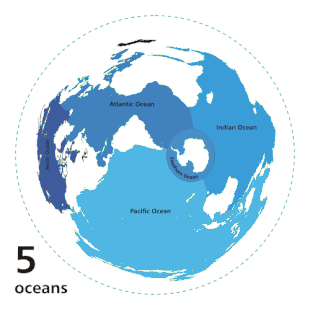   |
| Earth's ocean |
|---|
|
Main five oceans division: Further subdivision: Marginal seas |
The Gulf of Guinea is the northeasternmost part of the tropical Atlantic Ocean from Cape Lopez in Gabon, north and west to Cape Palmas in Liberia.[1] Null Island, defined as the intersection of the Equator and Prime Meridian (zero degrees latitude and longitude), is in the gulf.[2]
Among the many rivers that drain into the Gulf of Guinea are the Niger and the Volta. The coastline on the gulf includes the Bight of Benin and the Bight of Bonny.
Name
The origin of the name Guinea is thought to be an area in the region, although the specifics are disputed. Bovill (1995) gives a thorough description:[3]
The name Guinea is usually said to have been a corrupt form of the name Ghana, picked up by the Portuguese in the Maghrib. The present writer finds this unacceptable. The name Guinea has been in use both in the Maghrib and in Europe long before Prince Henry's time. For example, on a map dated about 1320 by the Genoese cartographer Giovanni di Carignano, who got his information about Africa from a fellow-countryman in Sijilmassa [ancient trading city in North Africa], we find Gunuia, and in the Catalan atlas of 1375 as Ginyia. A passage in Leo [Africanus] (vol. III, 822) points to Guinea having been a corrupt form of Jenne [2,000-year-old city in central Mali on Niger river], less famous than Ghana but nevertheless for many centuries famed in the Maghrib as a great market and a seat of learning. The relevant passage reads: "The Kingdom of Ghinea . . . called by the merchants of our nation Gheneoa, by the natural inhabitants thereof Genni and by the Portugals and other people of Europe Ghinea." But it seems more probable that Guinea derives from aguinaou, the Berber for Negro. Marrakech [city in southeastern Morocco] has a gate, built in the twelfth century, called the Bab Aguinaou, the Gate of the Negro (Delafosse, Haut-Sénégal-Niger, II, 277-278). The modern application of the name Guinea to the coast dates only from 1481. In that year the Portuguese built a fort, São Jorge da Mina (modern day Elmina), on the Gold Coast region, and their king, John II, was permitted by the Pope [Sixtus II or Innocent VIII] to style himself Lord of Guinea, a title that survived until the recent extinction of the monarchy.
The name "Guinea" was also applied to south coast of West Africa, north of the Gulf of Guinea, which became known as "Upper Guinea", and the west coast of Southern Africa, to the east, which became known as "Lower Guinea". The name "Guinea" is still attached to the names of three countries in Africa: Guinea, Guinea-Bissau, and Equatorial Guinea, as well as New Guinea in Melanesia.
Geography
The main river dispersing its waters in the gulf is the Niger River.
Different definitions of the geographic limits of the Gulf of Guinea are given; the International Hydrographic Organization defines the southwest extent of the Gulf of Guinea as "B line from Cap Lopez (0°37′S 8°43′E / 0.617°S 8.717°E), in Gabon, northwestward to Ihléu Gago Coutinho (Ilhéu das Rôlas) (0°01′S 6°32′E / 0.017°S 6.533°E); and thence a line from Ihléu Gago Coutinho northwestward to Cape Palmas (4°22′N 7°44′W / 4.367°N 7.733°W), in Liberia.[1]
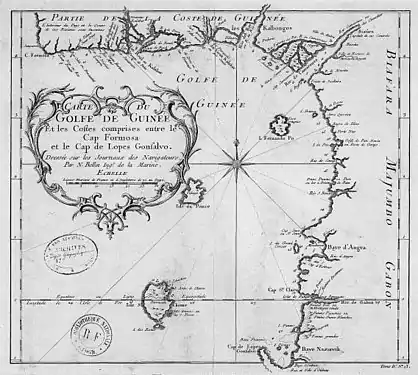 Old French map of the Gulf of Guinea
Old French map of the Gulf of Guinea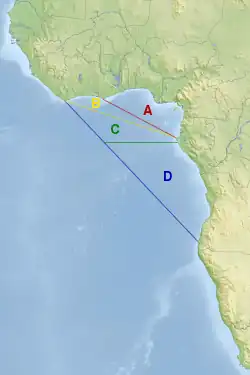 Different limits of the Gulf of Guinea
Different limits of the Gulf of Guinea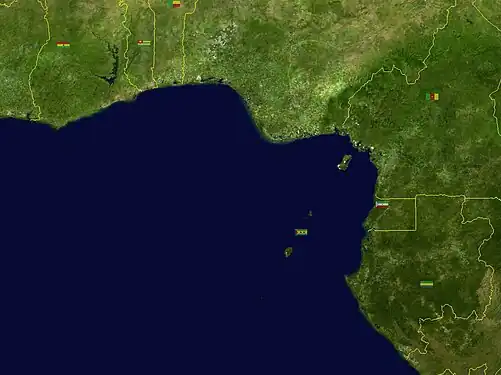 Satellite imagery of the Gulf of Guinea showing borders of states on its shores
Satellite imagery of the Gulf of Guinea showing borders of states on its shores
Islands in the Gulf of Guinea
The Gulf of Guinea contains a number of islands, the largest of which are in a southwest-northeast chain, forming part of the Cameroon line of volcanoes.
Annobón, also known as Pagalu or Pigalua, is an island that is part of Equatorial Guinea.
Bobowasi Island is an island off the west coast of Africa in the Gulf of Guinea that is part of the Western Region of Ghana.
Bioko is an island off the Ambazonian region of Cameroon in the Gulf of Guinea under the sovereignty of Equatorial Guinea.
Corisco is an island belonging to Equatorial Guinea.
Elobey Grande and Elobey Chico are two small islands belonging to Equatorial Guinea.
São Tomé and Príncipe (officially the Democratic Republic of São Tomé and Príncipe) is a Portuguese-speaking island nation in the Gulf of Guinea that became independent from Portugal in 1975. It is located off the western equatorial coast of Africa and consists of two islands, São Tomé and Príncipe. They are located about 140 kilometres (87 mi) apart and about 250 and 225 kilometres (155 and 140 mi), respectively, off the northwestern coast of Gabon. Both islands are part of an extinct volcanic mountain range. São Tomé, the sizeable southern island, is situated just north of the Equator.
Maritime security
Maritime security in the Gulf of Guinea consists of 18 sovereign states.[4] Multiple institutional mandates address maritime security in the Gulf of Guinea: The Economic Community of West African States (ECOWAS) and the Economic Community of Central African States (ECCAS).[4] Additionally, maritime security in the Gulf of Guinea is also addressed by the Gulf of Guinea Commission (GGC).[4] Maritime security in the Gulf of Guinea is characterised not only by piracy but by a myriad of maritime crimes despite piracy often dominating the conversation on maritime security. According to the ‘Priority Paper for the Danish Efforts to Combat Piracy and Other Types of Maritime Crime 2019-2022’ piracy and maritime crime are defined as follows:
Piracy can be defined as any illegal act of violence, detention or depredation committed for private ends at high seas against another ship or aircraft.[5] Maritime crime may include armed robbery at sea, trafficking of humans or smuggling of illicit goods, drugs and weapons, illegal fishing, fuel theft and more.[5]
The other notable crimes in the Gulf of Guinea are illegal fishing, kidnap for ransom, drug trafficking and oil-bunkering.[6] Illegal oil-bunkering consists of the attacking of vessels transporting oil and transferring the oil to the thieves’ own vessel, after which the oil is sold in local and international markets.[4]
Kidnapping for ransom is one of the most prevalent maritime crimes in the region. Between 2018 and 2019, the number of crew members that were kidnapped in the Gulf of Guinea increased by 50%, leading the region to account for 90% of global kidnappings at sea.[7]
See also
- Benin
- Cameroon
- Equatorial Guinea
- Gabon
- Ghana
- Guinea (region)
- Guineaman, a ship used to transport slaves from the region of Guinea
- Nigeria
- Null Island
- Togo
- Whales in Ghanaian waters
References
- 1 2 "Limits of Oceans and Seas, Draft 4th Edition: North Atlantic Ocean and its Sub-Divisions". International Hydrographic Organization. 2002. Archived from the original on 4 March 2016. Retrieved 5 April 2017.
- ↑ Rosenberg, Matt (30 January 2020). "Where Do the Prime Meridian and the Equator Intersect?". ThoughtCo. Retrieved 7 July 2022.
- ↑ Hale, Thomas A. "From the Griot of Roots to the Roots of Griot: A New Look at the Origins of a Controversial African Term for Bard" (PDF). Oral Tradition. Archived from the original (PDF) on 2017-12-02. Retrieved 2008-03-26.
- 1 2 3 4 Jessica., Larsen. Reconciling international priorities with local needs DENMARK AS A NEW SECURITY ACTOR IN THE GULF OF GUINEA. Danish Institute for International Studies. OCLC 1152018425. Archived from the original on 2022-02-12. Retrieved 2021-06-22.
- 1 2 Ministry of Foreign Affairs of Denmark. (2019). Priority paper for the Danish efforts to combat piracy and other types of maritime crime 2019-2022. Copenhagen: Ministry of Foreign Affairs of Denmark.
- ↑ Ministry of Foreign Affairs of Denmark. (2018). Gulf of Guinea Maritime Security Programme, 2019-2021. Copenhagen: Ministry of Foreign Affairs of Denmark.
- ↑ Nicoloso, Giulia (2020-07-17). "Stark increase in kidnapping at sea in the Gulf of Guinea". Critical Maritime Routes. Archived from the original on 2021-06-02. Retrieved 2021-05-30.
External links
- The Gulf of Guinea Commission – CGG – GGC (Archived 2018-09-23 at the Wayback Machine)